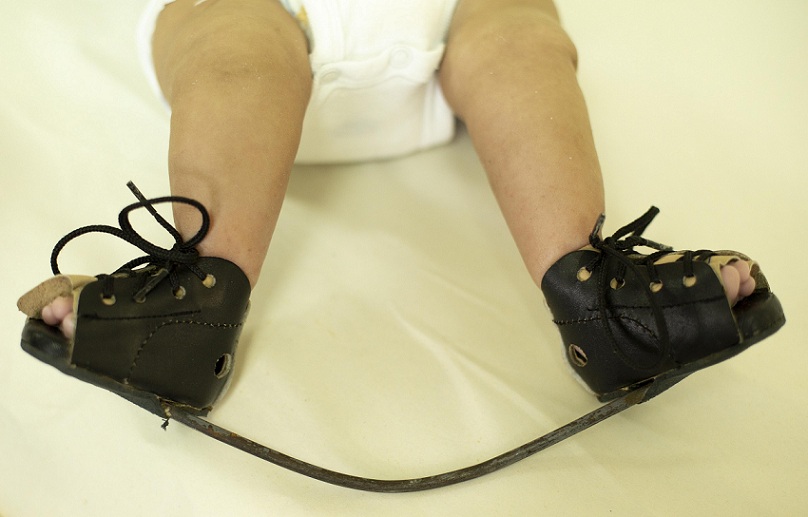Clubfoot is a common congenital condition (present during birth) in which the baby’s foot and ankle are twisted inward or downward. Also, the ligaments and tendons that connect bones to muscles are too tight or short, which causes tissues around the ankle to hold the foot in an abnormal position. The deformity is seen in about 1 in every 1,000 babies that affects more to a male child than a female. In most cases, a child born with clubfoot is healthy unless they are born with mechanical or neurological medical conditions like spina bifida or others.
Table of Contents
Diagnosis of Clubfoot
Depending upon the situation, most of the clubfoot cases can be detected before the child’s birth during the routine ultrasound examination (20 weeks of pregnancy). It cannot be cured or treated before birth but gives ample time to the doctor and parents to understand the condition and get in touch with the expert.
Soon after the birth, doctors will go for the X-ray to look for the shape, severity, and positioning of the affected feet. However, performing an X-ray is optional and is usually not necessary.
How Is Clubfoot Treated?
Newborns have flexible joints, tendons, and bones that make it easy for child orthopedics to treat clubfoot’s condition. It will initiate in the first or second week after the baby’s birth. Today the doctors aim to provide excellent treatment facilities so that the child’s foot looks normal and works in the right way preventing future disabilities or recurrence.
Treatment options include:
- Ponseti method (Stretching and Casting)
- Surgery
1. Ponseti Method
A non-surgical and effective clubfoot treatment which is initially performed for correcting Clubfoot’s deformity. It requires gentle stretching and casting to avoid surgical practices; mild cases can be cured within the period and last for a lifetime.
Ponseti Method is the common technique, during which the orthopedic will smoothly stretch the child’s foot into a normal position and secure it with a long length cast. After 8 to 10 days, the cast will be required to change along with the repositioning of the foot until the foot comes to the normal shape and position.
The standard time for the procedure requires 6 to 8 weeks without surgery. The best results are seen with the children treated within the period of the first two weeks of birth. In some cases, the doctor might need to perform a small minimal invasion process of Achilles tenotomy, which is required to loosen the feet and ankle’s tight muscles.
In case of severe clubfoot deformity, doctors may suggest you go for a surgical procedure if casting and stretching don’t bring the positive result in the first place.
2. Surgical Method
While performing surgery, the ortho-surgeon will lengthen the Achilles tendon around the ankle and release the foot tissues. It is rare to witness the need for tendon transfer. In the process, the tight ligaments are loosened while making small incisions that will help the surgeon manipulate the deformed foot into the correct position. Transfering tendon allows the foot to become flexible and perform movements in a normal manner.
In older children or adults, the deformity needs more extensive repair as muscles and bones get strong and less flexible. The condition cannot be rectified in a single surgery, and the procedure is known as Osteotomy.
Well, after the Achilles tenotomy, the child’s foot is secured with a cast for 6 to 8 months and requires bracing for a few years. Parents were trained and informed well-enough about precautions and maintaining the braces. In the first phase, it will require to be placed for 24 hours, and gradually the time period will decrease according to the healing and condition of the child’s foot.
Recovery
After the surgery, a child will remain in the hospital for 2 to 3 days. Cast will be applied and placed in the elevated position to reduce the swelling. After the discharge, the cast will remain applied until the incisions, tendons and treated bones heal within their time.
You will be asked to visit a doctor regularly, the cast will be replaced several times between weeks to months according to the growth and age of the child. Once the cast is removed, braces will be placed in the treated foot to prevent relapses of the clubfoot, and also it gives maximum support in walking to the child. By bracing the foot’s position, remain in the correct position, and assist in functioning better without any risk involved.
With growing age, doctors will advise going for the physical therapy that helps a lot in giving the successful outcomes of the surgery. The required foot exercises restore strength, flexibility, range of motion, and muscle tone to the affected leg.

